H
Habenaria: Habenaria rhodocheila is from Southeast Asia.
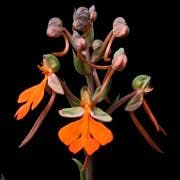
Habenaria (hab-ee-NARE-ee-a) There are more than 500 terrestrial species in this very widespread genus ranging around the world in temperate and tropical grassland regions. They are most numerous in tropical Africa, Asia and South America. Wildenow established the genus in 1805 and coined the generic name from the Greek word for "reins" to denote the straplike divisions of the sepals and petals.
HCC/AOS An American Orchid Society flower award denoting a Highly Commendable Certificate, awarded to an orchid species or hybrid that scores between 75 and 79 points out of a possible 100.
habit (hab-it) The characteristic form, aspect or mode of growth of a plant.
habitat (hab-ih-tat) The kind of locality in which a plant normally grows.
Haemaria (hee-MAY-ree-ah) A monotypic genus of highly variable terrestrial orchids from tropical Asia. Noted for its attractive foliage as one of the "jewel orchids," it was described by Lindley in 1826 but is now considered a synonym of the earlier genus Ludisia.
Hagsatera (hag-sa-TER-a) Mexico is the home of the two species in this genus that grow either epiphytically or lithophytically. Tamayo established the genus in 1974, naming it in honor of Eric Hágsater, editor of Orquidea, a Mexican journal.
hairs (hairz) A general name (technically known as trichomes for many kinds of small and slender outgrowths on the parts of plants; special kinds of hairiness are designated as setose, villous, comose, pubescent, hirsute etc.
halophyte (HAL-uh-fayt) Plants growing in saline soil.
hamate (HAY-mayt) Hook-shaped; having a hooklike process.
haploid (HAP-loyd) An individual or cell with only a single set of chromosomes. (n) The characteristic chromosome number of the gametes.
hapuu (hah-POO-oo) Hawaiian term for tree-fern fiber.
Haraella (ha-ra-EL-a) The two epiphytic species in this genus are native to Taiwan. Kudo described the genus in 1930 and named it in honor of Yoshi Hara, who discovered the material that became the type specimen.
harpophyllus, -a, -um (har-poh-FILL-us) Having sickle-shaped leaves.
Hartweg, Karl Theodore (1812—1871) A plant collector from Karlsruhe, Germany, who explored Mexico and the Andes for the Horticultural Society of London. He was commemorated by Lindley in the genus Hartwegia .
Hartwegia (hart-WEGG-ee-a) See Nageliella.
hastatus, -a, -um (has-TAY-tus) Like an arrowhead; spear-shaped; hastate.
hastilabius, -a, -um (has-ti-LAY-bee-us) With a spear-shaped lip.
Hawkes, A.D. (1927—1977) Prominent horticultural taxonomist whose work culminated in the Encyclopaedia of Cultivated Orchids (1965)
head (hed) A short dense spike; capitulum.
Helcia: Helcia sanguinolenta is now in the genus Trichopilia.
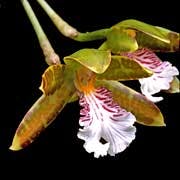
Helcia (HEL-see-a) Only one species is known in this genus native to Colombia and Ecuador. Lindley established the genus in 1840, deriving the generic name from the Greek word for "horse-collar or yoke," probably a reference to the hair on the pit at the base of the lip. Now included in the genus Trichopilia.
helicoid (HEL-i-koyd) Twisted or coiled in snail-shell form.
heliotropism (hee-lee-o-TROPE-ism) The characteristic of turning toward the light.
hemi- In Greek compounds, signifying "half."
hemiepiphyte (hem-ee-EPP-i-fyte) A plant, such as Vanilla, whose life history includes both terrestrial and epiphytic phases.
hepta- (HEHP-ta) In Greek compounds, signifying "seven."
herb (erb) A plant with no persistent woody stem above ground.
herbaceus, -a, -um (her-BAY-see-us) Herblike; not woody; green and succulent; herbaceous.
herbarium (her-BAIR-ee-um) A collection of dried (or otherwise preserved) plant specimens, annotated and identified, and systematically arranged.
herbarium specimen (her-BAIR-ee-um speh-SIH-men) A dried preserved plant mounted on a sheet of paper, synonymous with a herbarium sheet, also applied to associated research collections such as spirit-preserved flowers.
herbicide (her-bih-SIDE) The class of chemicals that is used to destroy plants.
Hermaphrodite: Catasetum pileatum flower that is a hermaphrodite.
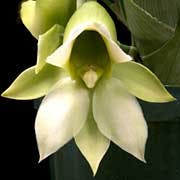
hermaphrodite (her-MAF-roh-dyte) A flower having the organs, characteristics or attributes of both sexes, hence, perfect.
hermaphroditic (her-maf-roh-DIT-ik) Pertaining to hermaphrodite; with the stamens and pistils in the same flower.
heterocarpus, -a, -um (het-er-o-KAR-pus) Having variable or various kinds of seed pods.
heterogamous (het-er-OG-a-muss) With two or more kinds or forms of flowers.
heterozygous (het-er-oh-ZY-guss) Pertaining to an individual that has inherited different alleles for a gene from each parent.
Hexadesmia (hex-a-DEZ-mee-a) There are about 15 epiphytic species in this genus native to the tropical Americas. Brongniart founded the genus in 1842, deriving the name from two Greek words meaning "six" and "chain or bond" to denote the six pollinia in two groups.
hexaploid (HEKS-ah-ployd) Having six sets of chromosomes (6N).
Hexisea: Formerly known as Hexisea bidentata, now in the genus Scaphyglottis.
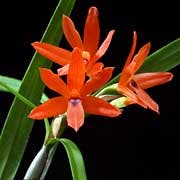
Hexisea (hex-EE-zee-a)) A genus of two species of epiphytic orchids from Meso-america and northern South America, related to Scaphyglottis, it was described in 1834 by Lindley, the name derived from the fact that the six segments of the flower's perianth are about equal in size and shape.
Himantoglossum (hi-man-toe-GLOSS-um) There are four or five robust terrestrial species in this genus native to northern Europe and the Middle East. The genus was first described by W.D. Kock in 1837, who derived the name from two Greek words meaning "strap" and "tongue" to denote the unusual lip.
hippocrepiform (hip-oh-KREP-ih-form) Shaped like a horseshoe.
Hirsute: The hirsute cane of Sobralia fenzliana.
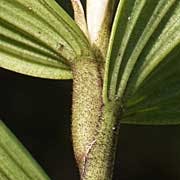
hirsute (HIR-soot) Covered with long, rather coarse or stiff hairs.
hirsutissimus, -a, -um (her-soo-TISS-eh-muss) Most hairy; very hairy.
Hispaniella (his-pan-EE-ell-a) This is a monotypic epiphytic genus from Hispaniola in the West Indies. G. Bream, in 1980, removed this species from Oncidium and established the new genus. He named it in honor of the island of Hispaniola.
hispidus, -a, -um (HISS-pid-us) Beset with rigid or bristly hairs or with bristles; hispid.
hispidulus, -a, -um (hiss-PID-yew-lus) Somewhat or minutely hispid; hispidulous.
hoary (HOHR-ee) Covered with a close white or whitish pubescence.
Hoehne, Frederico Carlos (1882–1959) Brazilian botanist who worked extensively on orchids, author of the Orchidaceae for the Flora Brasilica (1940–1953)
Holcoglossum (hole-koe-GLOSS-um) There are perhaps eight species in this epiphytic genus from Southeast Asia, ranging from Myanmar to Taiwan. Schlechter first described the genus in 1919, using the two Greek words for "strap" and "tongue" to denote the strap-shaped lip.
Holford, Lt. Col. Sir George L. (1860–1926) Son of Robert Holford, he inherited his father's fine collection of orchids at Westonbirt, Gloucester, Tetsbury, England, developing it into one of the world's greatest orchid collections; noted for its fine hybrid cattleyas and cymbidiums, particularly the tetraploid Cymbidium Alexanderi ‘Westonbirt', FCC/AOS.
holophyletic (HOHL-oh-fy-let-ick) Cladistic term referring to a phylogenetic group that is both monophyletic (from one ancestor) and includes all derivatives from that one ancestor.
holotype (hole-oh-TYPE) The specimen that was used for the original genus description.
Holttum, Richard Eric (1895–1990) Prominent English botanist, director of the Singapore Botanic Garden, expert on orchids, gingers and ferns, author of many orchid publications including the Orchidaceae for the Flora of Malaya.
Homalopetalum (ho-mal-oh-PET-al-um) A genus of four species of epiphytic orchids from tropical America. Allied to Sophronitis, it was described by R.A. Rolfe in 1896, the name referring to the uniformity of the petals and sepals.
homo- (ho-moh) In Greek compounds, signifying "alike" or "very similar."
homocarpous (ho-moh-KAR-pus) All the fruits, as of a flower head, alike.
homogamous (ho-MOG-ah-mus) Having flowers that do not differ sexually.
homologous (ho-MAHL-oh-gus) Corresponding in origin and in type of structure, but not necessarily in function. (See analogous)
homomorphous (hoh-moh-MOR-fus) Uniform; all the given parts alike; possessing perfect flowers of only one kind.
homonym (HOM-oh-nim) A scientific name that is has already been used by its earlier application to a different entity of the same type and hence untenable under the rules of taxonomic priority. For instance the use of Carria to describe a genus of orchids since the name has previously been used to describe another genus in the plant world.
homozygous (hoh-moh-ZYE-gus) An individual that possesses the same two alleles for a particular gene.
Hooker, Joseph Dalton (1817–1911) Successor to his father as director of the Royal Botanic Gardens, Kew. A worldwide botanical traveler with a keen interest in biogeography, he authored many botanical works and floras, including orchids of various regions; editor of Curtis' Botanical Magazine from 1865 to 1904, he was elected president of the Royal Society in 1873.
Hooker, William Jackson (1785–1865) A professor of botany at the University of Glasgow, he was in 1841 appointed first official director of the Royal Botanic Gardens at Kew, where his herbarium, along with those of Linnaeus, George Bentham and John Lindley, forms the basis of the Kew Herbarium.
hormone (HOR-mone) A chemical produced in one part of the body and transported to another area of the body where it affects growth and development.
horny (hor-nee) Hard and dense in texture; corneous.
host (host) A plant from which a parasitic plant derives its nourishment; a tree upon which an epiphyte grows.
Houlletia (hoo-LET-ee-ah) A tropical American genus of 10 species allied to Stanhopea, it was described by Brongniart in 1841 and dedicated to Houllet (1811–1890), a French horticulturist and assistant curator at the Jardin des Plantes, Paris, who collected the type species in Brazil.
Howeara (how-AR-ah) A hybrid genus derived from Leochilus, Oncidium and Rodriguezia created in 1976, named in honor of Stephen Howe, the hybridizer of the first cross.Now called Leomesezia.
humidity (hue-mid-ih-tee) The condition of dampness; the percentage of water vapor in the air out of the total amount capable of being contained at the same temperature (specifically, relative humidity).
humifuse (hum-ih-fuse) Spreading over the ground. Procumbent.
humilis, -e (HEW-mil-is) Low-growing; more dwarf than most of its kind.
humus (hue-muss) Decomposing organic matter in the soil.
Huntleya (HUNT-lee-ah) A genus of 10 species of epiphytic orchids from tropical America. Allied to Zygopetalum, it was described by Bateman in 1837, the name complimenting the Rev. J.T. Huntley, an English orchid enthusiast.
Hurst, Charles Chamberlain (1870–1947) British geneticist who was one of the first to apply scientific analysis to orchid breeding behavior, with particular attention to albinism, and who, with Rolfe, prepared a major book on manmade orchid hybrids, The Orchid Stud-Book (1909)
hyacinthinus, -a, -um (hye-a-sin-THYE-nus) Resembling a hyacinth.
hyaline (HYE-a-leen) Thin and translucent, rarely transparent.
hybrid (hye-brid) The offspring resulting from the union of a species or hybrid with another species or hybrid.
hybridization (hye-brid-I-ZAY-shun) Causing the production of hybrids by crossing different species, etc.
hydrophyte (hye-druh-fahyt) Said of plants growing near water.
hydroponics (hye-dro-PON-iks) A soilless method of growing orchids, using nutrient solutions and an inorganic supporting medium.
hyemalis, -e (hye-em-AY-lis) Of winter; flowering in winter. (Also spelled hiemalis)
Hygrochilus (hye-grow-KYE-luhs) This monotypic genus comes from Southeast Asia, ranging from India to southeast China. Pfitzer established the genus in 1897, choosing two Greek words for "wet" and "lip" to denote the nectar-producing channel on the lip.
hygroscopic (hye-groh-SKOP-ik) Capable of absorbing moisture from the atmosphere.
hyperboreus, -a, -um (hye-per-BOR-ee-us) Far northern.
hyphae (HYE-fee) The cylindrical threadlike filaments that constitute the vegetative body of a fungus.
hyphaematicus, -a, -um (hye-fee-MAT-i-kus) Blood red underneath.
hypochile (HYE-poh-kyle) The lower or basal part of the compound lip in some orchids; also hypochilium.
hypogaeous (hye-puh-JEE-uhs) Growing underground.
hystrix (HISS-triks) Bristly; like a porcupine.








